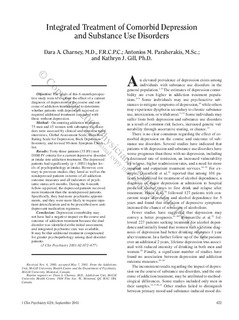| dc.contributor.author | Charney, D.A. | |
| dc.contributor.author | Paraherakis, A.M. | |
| dc.contributor.author | Gill, K.J. | |
| dc.date.accessioned | 2018-05-18T11:52:48Z | |
| dc.date.available | 2018-05-18T11:52:48Z | |
| dc.date.issued | 2001 | |
| dc.identifier.citation | Charney, D. A., Paraherakis, A. M., & Gill, K. J. (2001). Integrated treatment of comorbid depression and substance use disorders. Journal of Clinical Psychiatry, 62(9), 672–677. Hentet fra: https://www.psychiatrist.com/jcp/article/Pages/2001/v62n09/v62n0902.aspx | nb_NO |
| dc.identifier.uri | http://hdl.handle.net/11250/2498574 | |
| dc.description.abstract | OBJECTIVE:
The goals of this 6-month prospective study were to evaluate the effect of a current diagnosis of depression on the course and outcome of addiction treatment and to determine whether patients with depression received or required additional treatment compared with those without depression.
METHOD:
On entering addiction treatment, 75 men and 45 women with substance use disorders were assessed by clinical and semistructured interviews, Global Assessment Scale, Hamilton Rating Scale for Depression, Beck Depression Inventory, and revised 90-item Symptom Checklist.
RESULTS:
Forty-three patients (35.8%) met DSM-IV criteria for a current depressive disorder at intake into addiction treatment. The depressed patients had significantly (p < .0001) higher levels of psychopathology at intake. However, contrary to previous studies, they fared as well as the nondepressed patients in terms of all addiction outcome measures and all indicators of psychiatric status at 6 months. During the 6-month follow-up period, the depressed patients received more treatment than the nondepressed patients. Specifically, they had more psychiatric appointments, and they were more likely to require inpatient detoxification and to be prescribed new antidepressant medication regimens.
CONCLUSION:
Depression comorbidity may not have had a negative impact on the course and outcome of addiction treatment because the dual disorder was identified at the initial assessment, and integrated psychiatric care was available. It may be that additional treatment compensated for greater psychopathology among dual-disorder patients. | nb_NO |
| dc.publisher | Journal of Clinical Psychiatry | nb_NO |
| dc.subject | integrated treatment | nb_NO |
| dc.subject | comorbid depression | nb_NO |
| dc.subject | substance use disorders | nb_NO |
| dc.title | Integrated treatment of comorbid depression and substance use disorders | nb_NO |
| dc.type | Journal article | nb_NO |
| dc.source.pagenumber | 672–677 | nb_NO |
| dc.source.volume | 62 | nb_NO |
| dc.source.journal | Journal of Clinical Psychiatry | nb_NO |
| dc.source.issue | 9 | nb_NO |
